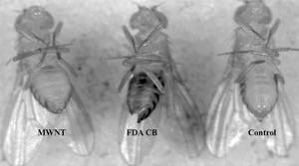Some Common Nanomaterials Toxic to Flies
A series of experiments in fruit flies suggests that different forms of carbon, though nearly chemically identical, have very different toxicities in fruit flies. Two of the materials caused physical impairment and mortality: carbon black, which is found in automobile tires and in an “activated” form in electrodes and filtration systems; and single-walled nanotubes, which are being explored for many electronics applications and are already used in composite materials.

Researchers at Brown University in Providence, RI exposed fruit-fly larvae and adults to four forms of carbon in their food and on their bodies. These included single-walled and multi-walled nanotubes, buckyballs, and carbon black. These materials are all based on meshes of carbon atoms in various forms. Nanotubes are rolled up sheets of carbon mesh in single or multiple layers; buckyballs are hollow spheres of the same mesh; and carbon black is made up of particles of elemental carbon.
The larvae could eat all four with no apparent adverse effects, though they did retain the particles in their tissues into adulthood. The researchers speculate that this could mean nanomaterials could accumulate and get passed up the food chain, just as DDT does.
In adult fruit flies, though, different forms of carbon had different effects. Adult fruit flies were dropped into test tubes containing the materials and observed as they made their way out or not. Buckyballs and multi-walled nanotubes didn’t seem to harm the flies, but carbon black and single-walled nanotubes maimed and killed them. And the multi-walled nanotubes could be carried on the flies’ bodies from one test tube to another just as other insects carry pollen, suggesting that they might act as vectors. The results were published online in the journal Environmental Science & Technology.
The Brown researchers will now try to determine the mechanism of the nanomaterials’ effects, and will test other common nanomaterials including nanosilver. They suspect that the toxicity of some forms of carbon is related to the particulate nature of the materials. Dust in a coal mine harms the lungs not primarily because it contains toxins but because of the physical effects of the particles; something similar might be happening to the flies. So, are the fruit flies are the canaries in the nano coal mine? It’s too early to say because what the results mean for humans is not clear. However, other researchers have previously reported that multi-walled nanotubes have the same carcinogenic effects as asbestos in the lungs of mice.
Keep Reading
Most Popular
Large language models can do jaw-dropping things. But nobody knows exactly why.
And that's a problem. Figuring it out is one of the biggest scientific puzzles of our time and a crucial step towards controlling more powerful future models.
The problem with plug-in hybrids? Their drivers.
Plug-in hybrids are often sold as a transition to EVs, but new data from Europe shows we’re still underestimating the emissions they produce.
How scientists traced a mysterious covid case back to six toilets
When wastewater surveillance turns into a hunt for a single infected individual, the ethics get tricky.
Google DeepMind’s new generative model makes Super Mario–like games from scratch
Genie learns how to control games by watching hours and hours of video. It could help train next-gen robots too.
Stay connected
Get the latest updates from
MIT Technology Review
Discover special offers, top stories, upcoming events, and more.